Onion
Microcontroller Boards
GNSS
Onion Omega2 LTE
A 4G LTE and Wi-Fi connected Linux dev board with GNSS global positioning
Funding ended on Jun 27, 2019 at 04:59 PM PDT.
Onion
Microcontroller Boards
GNSS
Funding ended on Jun 27, 2019 at 04:59 PM PDT.
Effortlessly deploy your IoT applications in remote areas without being limited by the range of Wi-Fi networks. The Omega2 LTE is the latest addition to the Omega2 family of Linux IoT computers, adding built-in high-speed 4G LTE cellular data connectivity and GNSS global positioning.
Smaller than a credit card, the Omega2 LTE is an all-inclusive, standalone computing device for developing cellular IoT applications. Just add a Nano-SIM card with a data plan, LTE antennas, and power it all up via USB or battery. The Linux network stack makes the switch between Wi-Fi and cellular data seamless to user applications. Take your existing NodeJS or Python IoT project outside the building with minimal effort! Or, use it as a fully-customizable cellular gateway for other Wi-Fi devices, deployed remotely or on the go.
The Omega2 LTE features an LTE Cat 4 modem that delivers 150 Mbps downlink and 50 Mbps uplink data rates. This same modem features the GNSS Receiver. It enables use cases that are not limited by the range of Wi-Fi networks since the 4G LTE data connection provides internet connectivity as long as there is cellular signal. And the Global Model even supports world-wide connectivity.
In addition to the cellular connectivity, the Omega2 LTE features a high-sensitivity, multi-constellation GNSS receiver, capable of retrieving positioning and accurate time data worldwide.
The Omega2 LTE supports all of the common positioning systems:
This further extends the possible use cases to include real-time asset and fleet tracking. Combined with the LTE data connection, it’s easy to build applications that report geoposition, an accurate timestamp, and other data to remote servers.
Even without an LTE data connection, the Omega2 LTE can determine its geoposition and the accurate time, enabling power-saving by locally caching data and turning on the LTE data connection to report data on an interval.
Enabling GNSS and reading the data can be done in just two commands:
# enable gnss data collection
o2lte gnss enable
# read positioning data once satellites lock
ubus call gps info
# GNSS data:
{
"age": 0,
"latitude": "43.727278",
"longitude": "-79.339722",
"elevation": "207.9",
"course": "7.5",
"speed": "0.0"
}
Like all Omega2 family devices, the Omega2 LTE is a whiz at Wi-Fi networking. The Wi-Fi interface can simultaneously host its own Wi-Fi access point and connect to existing Wi-Fi networks. With the addition of an Ethernet Expansion board, the network capabilities can extend to wired networks as well.
The LTE data connection benefits from the flexibility of the network stack as well. The network stack takes care of the low-level configuration of the LTE data connection, making the process easy for the user and seamless for any applications. In addition, the data connection can be shared over the Omega’s Wi-Fi access point with other Wi-Fi enabled devices.
A. 30-pin expansion header
B. LTE modem + GPS receiver
C. LTE status LEDs
D. LTE & GNSS U.FL antenna connectors
E. JST-PH battery connector
F. Power management
G. Power switch
H. USB-C (power & serial)
I. Programmable button
J. Omega2S+ module
K. Wi-Fi chip antenna
L. Omega status LEDs
A. Nano-SIM slot
B. MicroSD slot
The Omega2 LTE specializes in wireless networking, sporting 4G LTE connectivity and Wi-Fi capabilities, making it ideal for outdoor and remote sensor hub applications.
Since we started making IoT hardware in 2015, we’ve taken great care to listen to feedback from our community of developers, hackers, and makers to learn what they really need from their IoT devices and to make sure that community feedback drives our product decisions.
Community Feedback: Portability and resilience is important for IoT devices
The Omega2 LTE is flexible when it comes to power sources: it can be powered by LiPo batteries or USB power. An on-board battery management chip enables the use of LiPo batteries as the main power source, and will recharge the batteries when connected to USB power. Use a battery to make your project portable or to act as a back-up power supply.
Community Feedback: Easy access for configuration and debugging
The on-board USB-to-serial chip provides reliable, always-on access to the Omega’s command-line, which is invaluable for configuration and debugging device operation. Alternatively, you can securely connect a command-line terminal through the local network using SSH.
Community Feedback: Expandable storage
Use the microSD card slot on the bottom of the device to add gigabytes and gigabytes of additional storage to your Omega2 LTE. The ability to add storage space is essential for storing any assets created by the device — log files, images, etc. — or, occasionally, when project requirements change leading to the application taking up more space than originally planned.
Community Feedback: Easily check the status of the device
The Omega2 LTE uses a series of LEDs to provide visual feedback on the current status of the device:
| Status LED | Indicates |
|---|---|
| A. Green Power LED | Running on battery |
| B. Amber System status LED | Whether Linux OS has booted |
| C. Blue Wi-Fi status LED | Connection to a Wi-Fi network is active |
| D. Green Cellular network status | Connection to cellular network is active |
| E. Amber Cellular network activity | Transmitting and receiving cellular data |
The Omega2 LTE is the latest step in our community’s evolving vision for an IoT computer. It adds a new dimension of connectivity while also building on everything we’ve done with the Omega2 platform since it was first introduced in 2016. The result is a device that allows you to jump-start your development with a quick and easy setup, a familiar Linux environment, and support for your favorite programming languages.
The flash storage on the Omega2 LTE comes pre-loaded with a Linux operating system. To get started with your new Omega2 LTE, you only need the Omega2 LTE itself, a USB-C cable, and your computer - no keyboards, monitors, or anything else. Take a few minutes to step through the browser-based setup wizard and you’re ready to start building your cellular IoT device.
Use the command-line to configure and enable the LTE data connection:
# configure the Omega2 LTE to connect to your cellular data provider
o2lte apn ltedata.apn
# enable LTE cellular data
o2lte data enable
# share cellular data connection over Omega's Wi-Fi
o2lte share enable
The Omega2 LTE runs the latest OpenWrt embedded Linux operating system, which provides a flexible and powerful foundation for building your cellular IoT applications. Develop your project in your favorite language: Python, GoLang, NodeJS, PHP, C, C++, and many more are all supported. There’s also a wealth of existing packages available that can be installed with the built-in package manager so you don’t have to start from scratch.
The Linux network stack manages all of the connectivity interfaces the Omega2 LTE offers — LTE data, Wi-Fi, and Ethernet — making it easy to manage without knowledge of the low-level details and, most importantly, making internet connectivity transparent to your applications.
Hosted on the Omega2 LTE, OnionOS provides an intuitive user interface through your browser. Write code, run commands, and use apps to interact with your Omega2 LTE, no installation required.
The Terminal and Code Editor apps make OnionOS a development environment that works on any computer. Use it for initial development or as an easily-accessible IDE for projects that have already been deployed.
With the OnionOS App Manager, you can install more OnionOS apps and do even more from your browser.
With extensive I/O, it is easy to interface the Omega2 LTE with other devices and components depending on the needs of your application.
On top of that, it has the benefit of being compatible with the existing ecosystem of Omega2 expansions. This ecosystem of plug-and-play additions are a modular way of adding specific functionality to your device.
Above expansions: NFC/RFID, ADC, OLED
Above expansions: Servo (PWM), Ethernet, Proto
| Expansion | Description |
|---|---|
| NFC/RFID | Standard 13.56 MHz RFID and NFC reader and writer |
| ADC | Four-channel, 16-bit analog to digital converter |
| OLED Screen | Low-power, 0.96" diagonal, monochrome display with 128 x 64 pixels |
| Servo (PWM) | Generate up to 16 different, free-running, pulse-width-modulated signals |
| Ethernet | Wired 10/100 network connectivity via a standard Ethernet cable |
| Proto | A blank slate of 185 pads on which to solder your own circuit |
The IoT landscape is evolving and extending beyond the reach of Wi-Fi networks. The Omega2 LTE builds on everything that makes the Omega2 platform great, and adds cellular connectivity, opening the door to a variety of remote and outdoor use cases.
The Omega2 LTE is comes in two variants: a model that is compatible with cellular networks in North America, and a Global model that supports network bands around the world:
| Cellular Technology | Omega2 LTE | Omega2 LTE Global Model |
|---|---|---|
| 4G LTE (FDD) | B2, B4, B12 | B1, B2, B3, B4, B5, B7, B8, B12, B13, B26, B18, B19, B20, B28 |
| 4G LTE (TDD) | - | B38, B29, B40, B41 |
| 3G UMTS WCDMA | B2, B4, B5 | B1, B2, B4, B5, B8, B6, B19 |
Neither Omega2 LTE models are locked to a specific cellular network provider and both will work with any provider as long as it supports the provider’s main band.
| Omega2 LTE | Omega2 LTE Global Model | ||
|---|---|---|---|
| USA | AT&T | Yes | Yes |
| T-Mobile | Yes | Yes | |
| Verizon | Yes | ||
| Canada | Rogers Wireless | Yes | Yes |
| Fido | Yes | Yes | |
| Telus Mobility | Yes | Yes | |
| Bell Mobility | Yes | Yes | |
| Europe | Orange | Yes | |
| Vodafone (Italy, UK, Germany, Spain) | Yes | ||
| O2 (Germany, UK, Czech Republic, Slovakia) | Yes | ||
| T-Mobile (Netherlands, Germany, Austria, Poland, Czech Republic) | Yes | ||
| SFR France | Yes | ||
| EE UK | Yes | ||
| Three (UK, Ireland) | Yes | ||
| Asia | Yes | ||
| South America | Yes | ||
| Africa | Yes | ||
| Oceania | Yes |
To connect, insert a Nano-SIM in the slot on the bottom of the device and use our command-line utility to specify the APN (Access Point Name) of your cellular provider.
To offer flexibility in choosing antennas, the Omega2 LTE features U.FL antenna connectors for connecting two LTE antennas and a GNSS antenna. The Omega2 LTE needs these antennas to connect to cellular networks and GNSS satellites. GNSS is best suited for outdoor use, as it’s not very likely to lock on to any positioning satellites when indoors.
1. 4G LTE Main
2. GNSS
3. 4G LTE Diversity
You’ll notice there are two antennas marked 4G: one is the main antenna, and the other is a diversity antenna. The main and diversity antennas work together to improve the quality and reliability of the wireless link. While it is possible to just use the main antenna and get cellular reception, using the diversity antenna as well will increase reception, especially indoors.
We’re offering two antenna options so you can tailor the Omega2 LTE to suit your needs.
This Onion-branded antenna sports three distinct antennas in one package: main and diversity 4G LTE antennas that support global cellular frequencies, and a GNSS (GPS & GLONASS) antenna. The antenna is physically flexible and features an adhesive on the bottom, making it a great form-factor for use with enclosures or when space is at a premium. Overall, it’s excellent for portable projects.
| 3-in-1 Flex Antenna | |
|---|---|
| Cellular Coverage | Worldwide 4G LTE, 3G, and 2G support |
| Supported Cellular Bands | B1-B23, B25-B29, B33-B42 |
| LTE Peak Gain | 3.4 - 5.2 dBi depending on the band |
| GNSS Coverage | GPS, GLONASS, Galileo, BeiDou, QZSS |
| GNSS Frequency Range | 1570 - 1610 MHz |
| GNSS Peak Gain | 0.8 dBi |
| Impedance | 50 ohm |
| Dimensions | 224 x 20 mm |
| Mechanical | Flexible and foldable, 3M adhesive on the bottom |
This kit features three separate antennas for the best possible reception. There are two standing, global LTE antennas and a patch GNSS antenna. All antennas feature magnetic mounts, making this kit ideal for mounting on vehicles or for permanent installations.
| LTE Antenna | GNSS Antenna | |
|---|---|---|
| Supported Protocols | Worldwide 4G, 3G, and 2G Support | GPS, BeiDou |
| Frequency Range | 700, 800, 850, 900, 1800, 1900, 2000, 2300, 2400, and 2600 MHz | 1575.42 +/- 4 MHz |
| Gain | 12 dBi | 3 dBi |
| Impedance | 50 ohm | 50 ohm |
| Antenna Dimensions | 31 cm tall | 38 x 46 x 12 mm |
| Cable Length | 2 m | 2 m |
The Omega2 LTE has all the hardware and software you need for:
Use high-level programming languages to quickly write device-side programs for real-time asset tracking or even fleet management. With the GNSS receiver providing location data and accurate time-stamps, and the LTE data connection providing internet connectivity, it’s straightforward to write an application in Python, NodeJS, GoLang, and others to report asset location details to an online server.
Expand the reach of your IoT projects and deployments to anywhere that has cellular reception with the Omega2 LTE. Use your favorite programming language to collect data from I²C, one-wire, SPI, digital, or analog sensors, and report it to an online service or API endpoint. Then, add a SIM card to report the data over the cellular network, and you can deploy your cellular IoT sensor device almost effortlessly.
The Omega2 LTE provides a platform for software developers to leverage their experience with Javascript and NodeJS to create IoT hardware. This includes remote sensor nodes, sensor hubs, or remote actuators that take action based on remote commands.
The Omega2 LTE can share its cellular data connection with other devices. Use one command to enable cellular data sharing over the Omega’s Wi-Fi acces point: {o2lte-graphics-03}
Or, add an Ethernet Expansion board and provide wired internet connectivity over Ethernet:
We’ve been iterating on the Omega IoT computer since 2015. The Omega2 LTE is the first of our line of IoT computers to add built-in cellular connectivity and positioning capabilities, while building on everything our community has come to love about the Omega2 family.
| Omega2 LTE | Omega2 Pro | Omega2+ on Expansion Dock | Omega2 on Power Dock 2 | |
|---|---|---|---|---|
| Processor | 580 MHz MIPS | 580 MHz MIPS | 580 MHz MIPS | 580 MHz MIPS |
| Memory | 128 MB | 128 MB RAM & 384 MB Swap File | 128 MB | 64 MB |
| Storage | 32 MB | 8 GB | 32 MB | 16 MB |
| Wi-Fi | 2.4 GHz b/g/n Access Point & Client | 2.4 GHz b/g/n Access Point & Client | 2.4 GHz b/g/n Access Point & Client | 2.4 GHz b/g/n Access Point & Client |
| Cellular | High-speed 4G LTE built-in | No | No | No |
| Global Positioning | GNSS support built-in | No | No | No |
| Battery Management | LiPo (use and charge) | LiPo (use and charge) | None | LiPo (use and charge) |
| Expandable Storage | Yes, microSD slot | No | Yes, microSD slot | No |
| USB Serial | Yes, USB-C port | Yes, Micro-USB port | Yes, Micro-USB port | No |
| USB 2.0 Host | None | Yes, one | Yes, one | Yes, one |
| Power Requirements | 5 V, 500 mA USB | 5 V, 500 mA USB | 5 V, 500 mA USB | 5 V, 500 mA USB |
You can think of the Omega2 LTE as an Omega2+ built into a Dock that combines the Expansion Dock, Power Dock 2, an upgraded GPS Expansion, and a 4G LTE modem.
As a small, standalone, all-in-one device featuring a microprocessor, Linux OS, Wi-Fi-connectivity, high-speed 4G LTE cellular data connectivity, and positioning capabilities, the Omega2 LTE is in a league of its own. However, we still think its worthwhile to compare it to other offerings:
| Omega2 LTE | Raspberry Pi w/ Hologram Nova Dongle | Raspberry Pi w/ LTE HAT | Particle Boron 2G/3G | Verizon Jetpack MiFi 8800L LTE Mobile Hotspot | |
|---|---|---|---|---|---|
| Processor | 580 MHz MIPS | 1.4 GHz Cortex-A52 | 1.4 GHz Cortex-A52 | ARM Cortex-M4F microcontroller | Qualcomm SDx20 |
| Memory | 128 MB | 1 GB | 1 GB | 256 KB | 128 MB |
| Storage | 32 MB Flash + microSD slot | None - microSD | None - microSD | 1 MB Flash | 256 MB |
| Wi-Fi | 2.4 GHz b/g/n access point & client | 2.4 GHz b/g/n client | 2.4 GHz b/g/n client | None | 2.4 & 5 GHz b/g/n/ac access point |
| Cellular Network Support | 4G LTE Cat 4 | 3G | 4G LTE Cat 4 | 3G | 4G LTE Cat 18 |
| Downlink Data Rate | 150 Mbps | 7.2 Mbps | 150 Mbps | 7.2 Mbps | 18 Mbps |
| Uplink Data Rate | 50 Mbps | 5.76 Mbit/s | 50 Mbps | 5.76 Mbps | 13 Mbps |
| SIM | Nano-SIM slot | Built-in | Nano-SIM slot | Built-in + Nano-SIM slot | Built-in |
| Positioning Support | GNSS | None | GNSS | None | None |
| Programmable | Yes. All modern programming languages | Yes. All modern programming languages | Yes. All modern programming languages | Yes. C++ only | No. No access to operating system at all |
| Battery Management | LiPo (use and charge) | No | No | LiPo (use and charge) | Built-in battery |
| USB Serial | Yes | No | No | No | No |
| Power | 5 V 0.5 A | 5 V 2.5 A | 5 V 2.5 A | 5 V 2 A | ? |
| Form-factor | All-in-one | Board + USB dongle | Board + HATs | All-in-one | Consumer device |
| Dimensions | 80 x 50 x 10 mm | (85 + 46) x 56 x 17 mm | 85 x 56 x (17 + 5) mm | 23 x 50 mm | 113 x 71 x 19.15 mm |
| Open Source | Yes | No | No | Yes | No |
| Path to Production | Yes | No | No | Yes | No |
| Total Cost | $99 (includes US shipping) | $124 | $154 | $69 | $199 |
This project builds on the success of our community, which is years in the making and thousands strong. They have contributed an enormous amount of examples, use cases, demos, questions, answers, and tutorials.
Every Omega2 LTE will be manufactured by our contract manufacturer (CM) in Shenzhen, China. We’ve been working with the CM since 2016 and have successfully produced tens of thousands of boards. Here’s how the process works.
To start, a sub-contractor printed circuit board (PCB) producer will fabricate the PCBs. This will be the longest part of manufacturing, taking about three weeks from start to finish. Once completed, the PCBs will be delivered to our CM who will inspect and electrically test all traces. In the meantime, our manufacturing team and the CM’s purchasing department will have amassed all of the discrete components required to build the Omega2 LTE final product.
Using a pick and place machine, all of the components will be placed on the PCBs. The PCBs will then be passed through a reflow oven to permanently attach the components. Visual inspection using an AOI (Automated Optical Inspection) machine is then done to make sure all components have been properly oriented and properly attached. The boards can then be called a PCBA (Assembled Printed Circuit Board).
Completed Omega2 LTE samples
The next step is crucial: testing! First up is basic electrical testing. After that, each unit will have a turn in the testing rig that connects to all of the I/Os.
The first test is what we call a "sanity test": we’ll boot the device make sure the current draw is a normal value (anything otherwise would suggest a manufacturing defect) and that the device successfully boots into the bootloader (code that runs before the operating system — think of it like the Omega’s BIOS). Using the bootloader, we’ll test the operation of all of the GPIOs and confirm the network adapter’s MAC address. The device will then be rebooted into the Linux operating system to run self-test programs that ensure the correct firmware is installed and the Wi-Fi radio is properly calibrated for maximum range and data integrity.
The final tests revolve around the LTE module, ensuring that it:
Units that don’t pass a step in this series of tests are marked and later inspected to find the root cause of the failure and improve the manufacturing process for the next run.
All Omega2 LTE devices will be shipped to our end customers using Crowd Supply’s fulfillment services. Once manufacturing is completed, we’ll make a bulk shipment to Crowd Supply and from there, the packages will be shipped out to our individual backers. For more information, you can refer to this useful guide to ordering, paying, and shipping.
All of the inherent risks of any electronics manufacturing endeavor apply to the Omega2 LTE — component availability may delay production, PCB production yield could be low, or assembly yield could be low, to name a few potential issues.
Having said that, we’ve been designing and manufacturing IoT hardware since 2015 and we’re confident in our ability to deliver a quality product in the expected timeline. Based on our experience, we’ve taken steps to minimize risk in the Omega2 LTE project:
We believe that honesty is the best policy and will keep our backers informed every step of the way. If we do encounter any hiccups, speed bumps, or road blocks, we will be open and transparent about the issues and how they affect our delivery timelines. We have done this before, and we will not stop until we have delivered everything!
"The Omega2 LTE is based on the Omega2S+ with added 4G LTE support and integrated GNSS for increased networking capabilities."
Produced by Onion in Boston, MA.
Sold and shipped by Crowd Supply.

An Omega2 LTE IoT computer to build your own cellular IoT projects with Linux. You'll need an antenna for LTE and GNSS connectivity.
Want to buy this item? Check the current project page for the latest information.

An all-in-one starter antenna that's good for use worldwide. The antenna sports two LTE antennas for better indoor reception and a GNSS antenna that's good for use outdoors.
Want to buy this item? Check the current project page for the latest information.

Get the best reception for your IoT project with the Pro Antenna Kit. Features two suction-mount LTE antennas, a magnetic mount GNSS antenna, and three SMA to U.FL adapters for easy connection to the Omega2 LTE.
Want to buy this item? Check the current project page for the latest information.

1x Omega2 LTE, 1x Ethernet Expansion, 1x ADC Expansion, 1x 3-in-1 Flex Antenna
Want to buy this item? Check the current project page for the latest information.

1x Omega2 LTE, 1x Ethernet Expansion, 1x OLED Expansion, 1x Servo Expansion, 1x ADC Expansion, 1x NFC Expansion, 1x Proto Expansion, 1x 3-in-1 Flex Antenna, 1x Pro Antenna Kit
Want to buy this item? Check the current project page for the latest information.

Four Omega2 LTE devices! Get that cellular IoT project up and running! Remember that you'll need antennas for LTE and GNSS connectivity.
Want to buy this item? Check the current project page for the latest information.
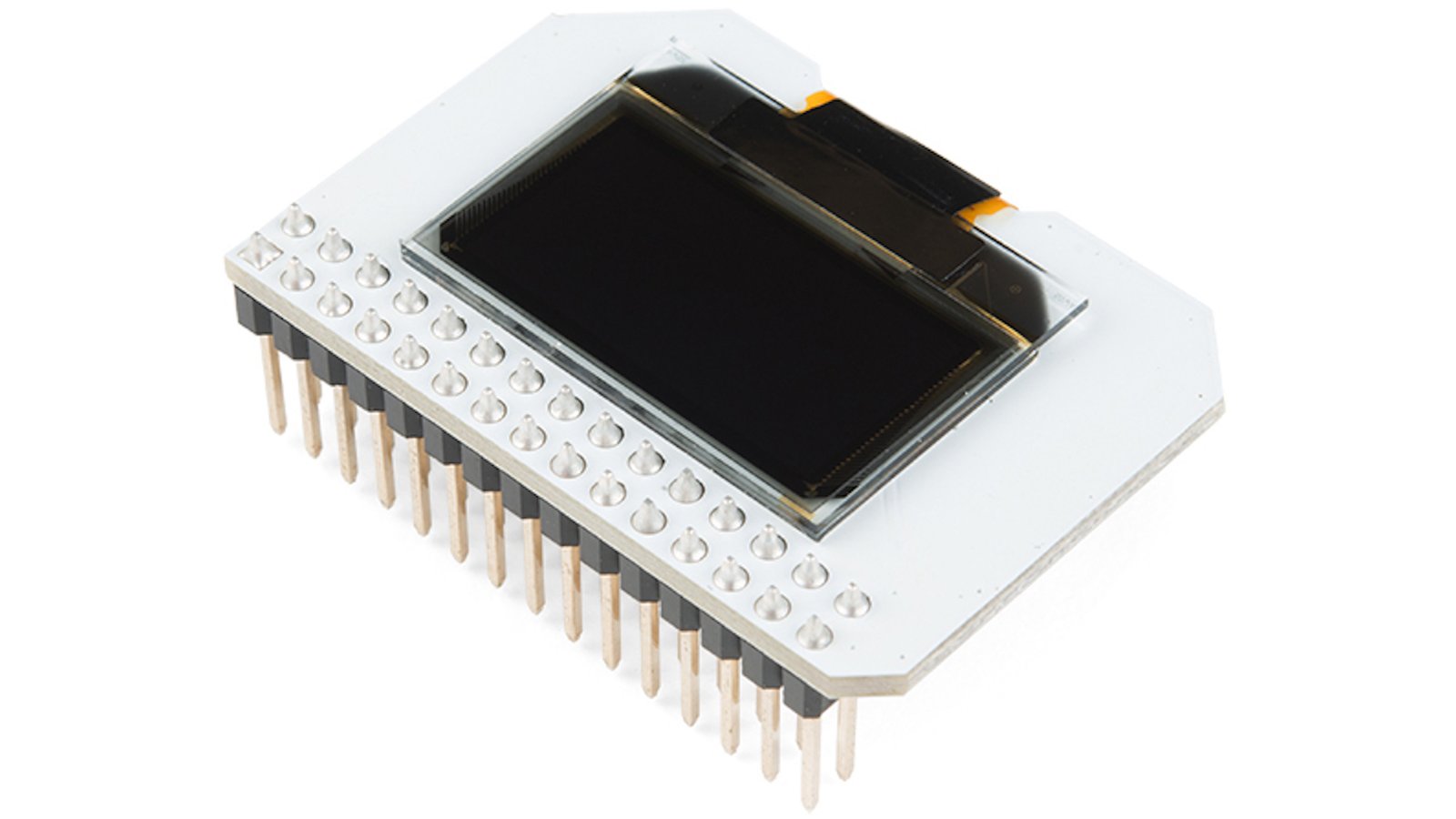
From the Onion Omega2 Pro project.
An OLED Expansion board for your Omega2 LTE
The OLED Expansion adds a low-power 0.96″ monochrome display to your Omega. With a resolution of 128×64, you can use it to display text, images, and even animations. Very useful for displaying status information, web data, and small logos.
Want to buy this item? Check the current project page for the latest information.
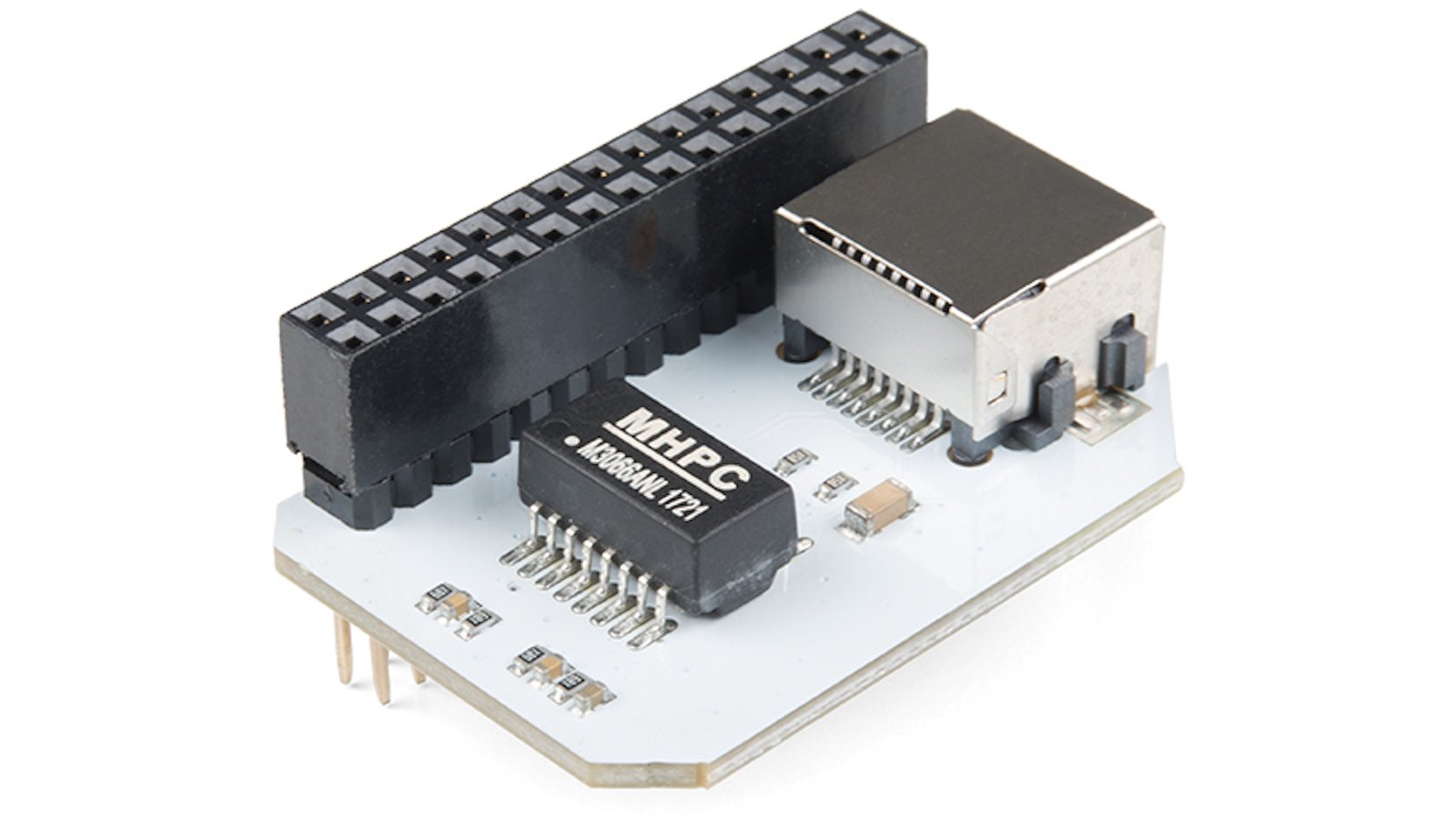
From the Onion Omega2 Pro project.
An Ethernet Expansion board for your Omega2 LTE
The Ethernet Expansion adds an Ethernet port to your Omega with a maximum connection speed of 100Mbps. While the Omega is all about wireless connectivity, a reliable wired network connection can be a great addition to a project, and the Ethernet Expansion is a great tool for quickly reflashing your Omega’s firmware.
Want to buy this item? Check the current project page for the latest information.
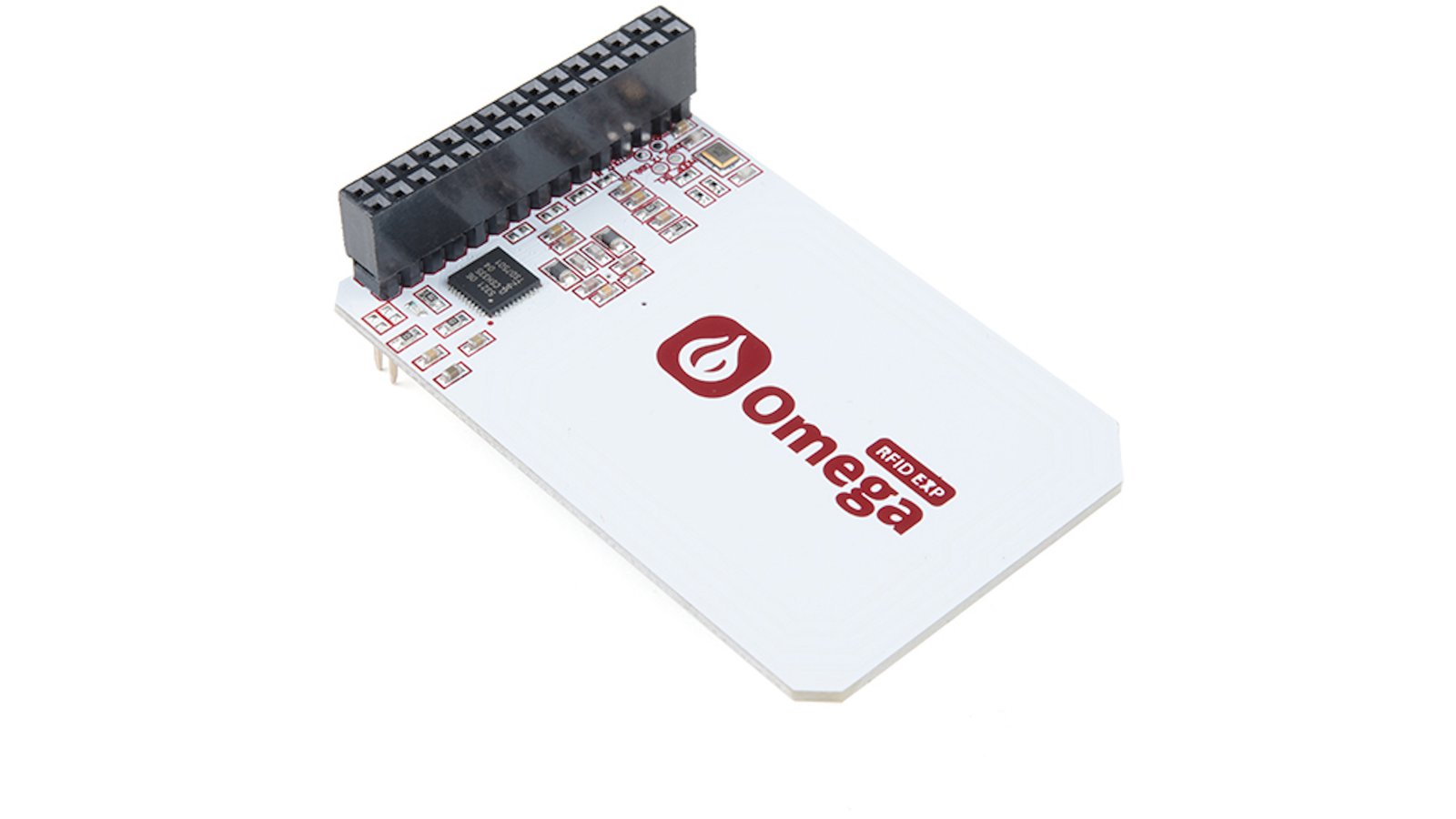
From the Onion Omega2 Pro project.
A NFC/RFID Expansion board for your Omega2 LTE
Bring contact-less RFID and NFC communication to your Omega2. It supports reading and writing with several NFC and RFID protocols at 13.56 MHz. Comes bundled with two programmable Mifare Ultralight tags.
Want to buy this item? Check the current project page for the latest information.

From the Onion Omega2 Pro project.
An ADC Expansion board for your Omega2 LTE
Omega2 can now read all types of analog voltages and sensors with the help of this ADC Expansion. Read and interpret up to 4 analog voltage or sensor inputs, each with 16 bits of precision.
Want to buy this item? Check the current project page for the latest information.
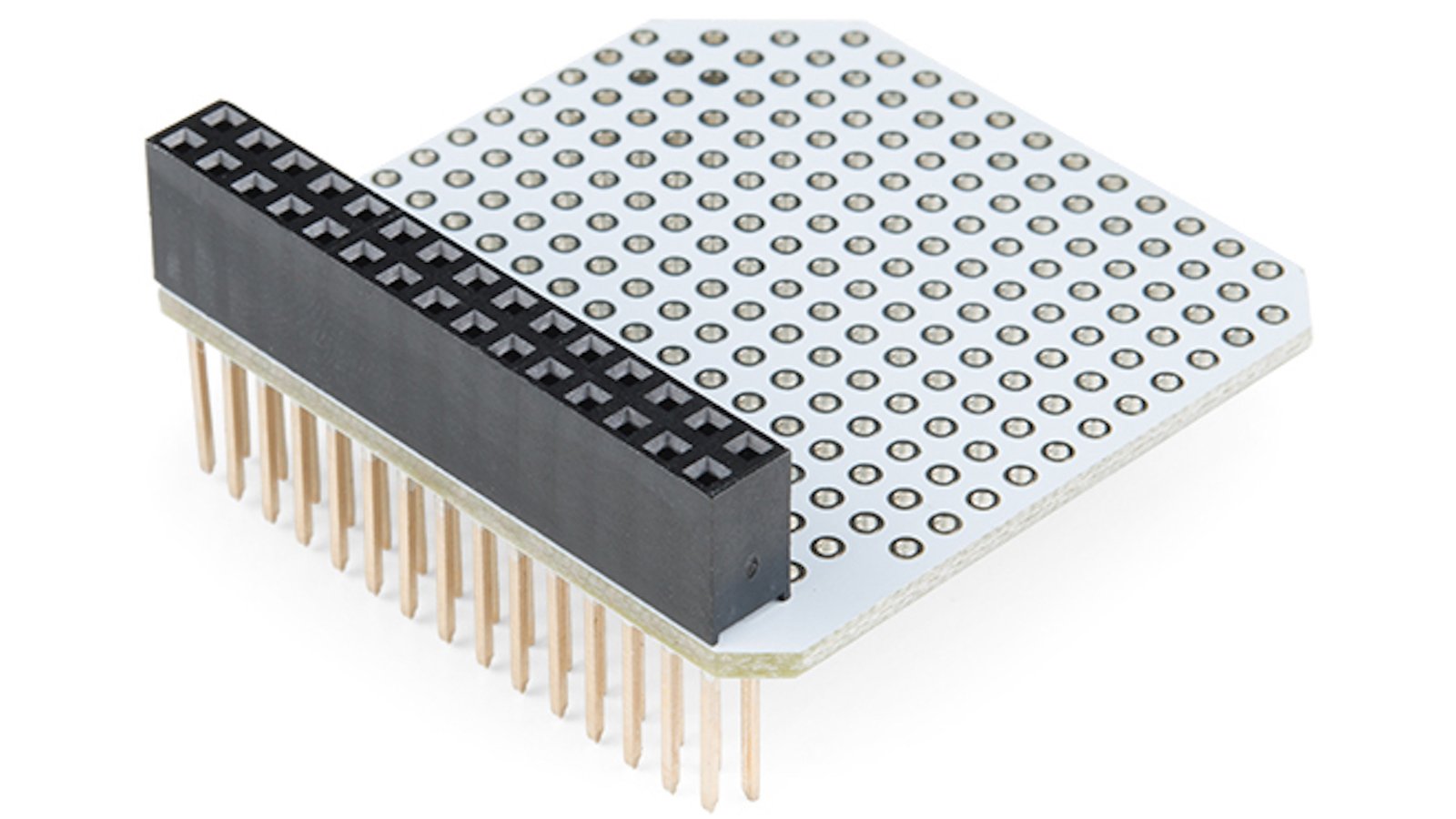
From the Onion Omega2 Pro project.
A Proto Expansion board for your Omega2 LTE
The Proto Expansion for the Onion Omega allows you to create your very own expansion that interfaces with your Omega. It provides a small soldering area and 30-pin header that plugs into the Expansion Dock. With it you will have full control over what kind of project you design for your Omega.
Want to buy this item? Check the current project page for the latest information.
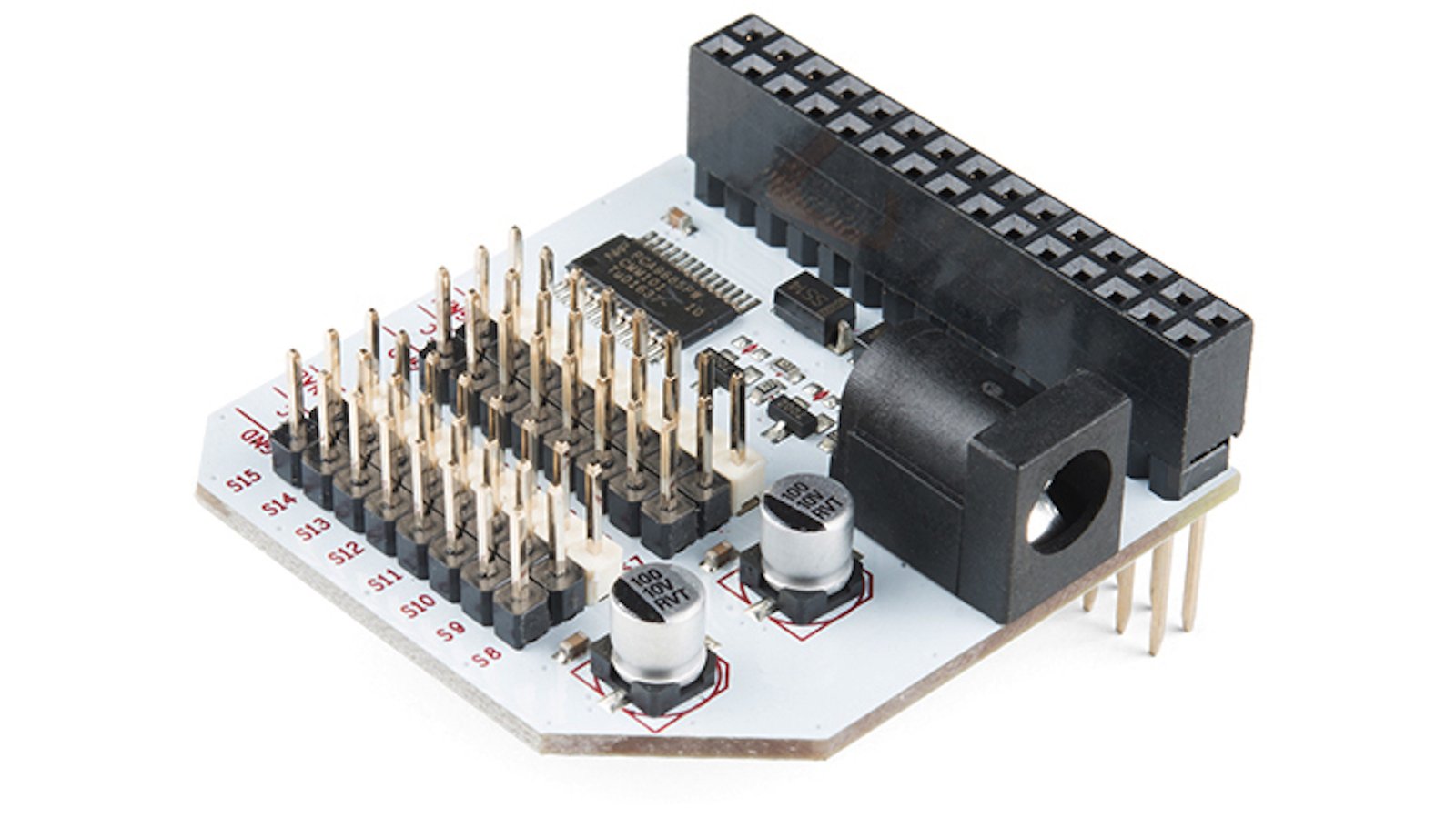
From the Onion Omega2 Pro project.
A Servo Expansion board for your Omega2 LTE
The Servo Expansion adds 16 PWM (Pulse Width Modulation) outputs to your Omega. Connect standard servos directly to the Expansion since each channel has its own 3-pin connectors, making it that much easier to get started with your project! This Expansion is great in any application that requires servos, like a robotics project or anything with moving parts. Given that PWM is so useful, you can also use this Expansion to precisely control LEDs or drive a DC motor using an H-bridge. The Servo Expansion is often also called the PWM Expansion.
Want to buy this item? Check the current project page for the latest information.

· onion.io · OnionIoT · OnionIoT
Onion is a team of technology enthusiasts, creators, and strivers, looking to make amazing products and even better user experiences. Onion has been in business since 2014, graduating from the TechStars Startup Accelerator in Boston that year. In 2015, we introduced the world to the Onion Omega IoT computer.